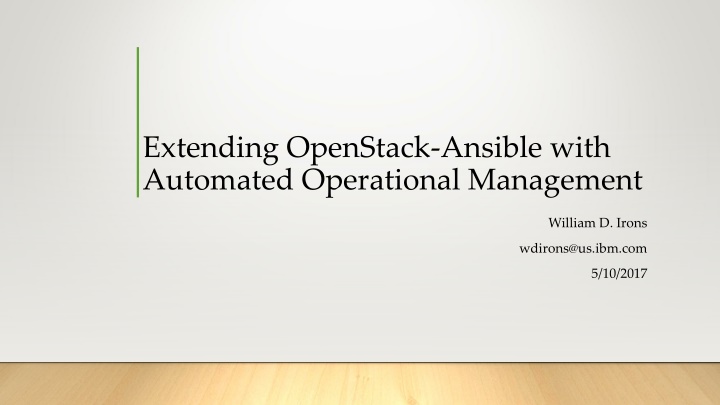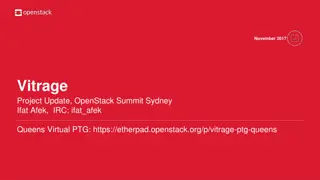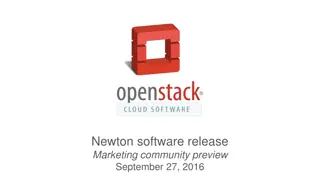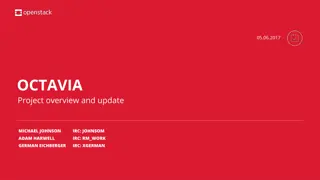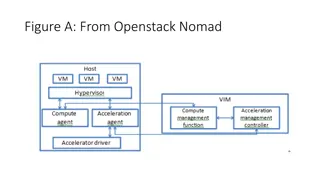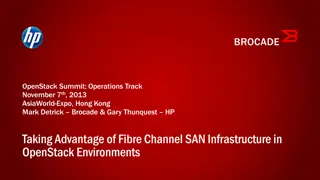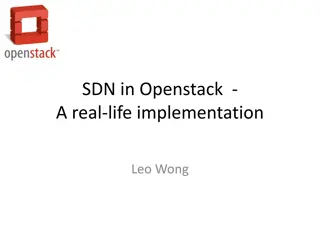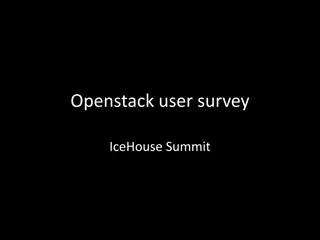Extending OpenStack-Ansible with Automated Operational Management
How OpenStack-Ansible can be extended for automated operational management. Discover the implementation of Elastic Stack for monitoring, and learn about creating customizations using LXC containers, playbooks, and variable files.
Download Presentation

Please find below an Image/Link to download the presentation.
The content on the website is provided AS IS for your information and personal use only. It may not be sold, licensed, or shared on other websites without obtaining consent from the author.If you encounter any issues during the download, it is possible that the publisher has removed the file from their server.
You are allowed to download the files provided on this website for personal or commercial use, subject to the condition that they are used lawfully. All files are the property of their respective owners.
The content on the website is provided AS IS for your information and personal use only. It may not be sold, licensed, or shared on other websites without obtaining consent from the author.
E N D
Presentation Transcript
Extending OpenStack-Ansible with Automated Operational Management William D. Irons wdirons@us.ibm.com 5/10/2017
Agenda Background OpenStack Ansible and How It Can Be Extended Operational Manager (OpsMgr) Demo
Agenda Background OpenStack Ansible and How It Can Be Extended Operational Manager (OpsMgr) Demo
Background OpenStack Ansible [OSA] provides a fully automated and consistent install of OpenStack. However the monitoring of the environment after it is installed is lacking. Rackspace has already extended OpenStack Ansible to install Elastic Stack on an OpenStack Cluster Using the Rackspace concepts and some existing in house work we built a solution to monitor hardware and the applications running on that hardware using Nagios Core and Elastic Stack.
Operational Management Background Hardware Setup Database as a Service This is part of a larger effort to provide open source reference architectures for running OpenStack and Ceph on IBM Power hardware and providing tools to provision the hardware, install the applications and monitor the entire cluster. OpenStack Cloud Toolkit for OpenPOWER Block Storage Private Cloud Operational Management works on both x86_64 and Power LE, Ubuntu 16.04 Object Storage Currently using the Newton branch of OSA
Agenda Background OpenStack Ansible and How It Can Be Extended Operational Manager (OpsMgr) Demo
OpenStack Ansible Ansible is an open source automation platform Uses SSH to configure each endpoint and not agents OpenStack Ansible provides Ansible playbooks for the deployment and configuration of an OpenStack cluster LXC Containers for each OpenStack service haproxy to provide both high availability and load balancing between multiple controller nodes and proxy the request from the host to the back end LXC Containers
Extending OpenStack Ansible The main purpose for extending OpenStack Ansible is to install your own customizations in the same consistent manner that OpenStack is being installed with. Four main things to do: Create LXC Containers for additional services Playbooks for installing custom services and configuration Variable files for user defined variables Haproxy configuration for accessing the services
Create LXC Containers for additional services Need to create yml files under /etc/openstack_deploy/env.d for each container to create elasticsearch.yml --- component_skel: elasticsearch: belongs_to: - elasticsearch_all Running the setup-host.yml playbook from OSA will create the containers Or you could write your own playbook to create the LXC containers container_skel: elasticsearch_container: belongs_to: - log_containers contains: - elasticsearch properties: service_name: elasticsearch Need to ensure you don t have IP address conflicts with OSA containers
Playbooks for custom services and configuration Ansible playbooks are necessary for installing the custom services and any configuration of those services. Playbooks may be placed in any directory. An ansible.cfg file should be created to reference the OpenStack Ansible scripts as necessary: library = /etc/ansible/roles/plugins/action roles_path = /opt/openstack-ansible/playbooks/roles:/etc/ansible/roles inventory = /opt/openstack-ansible/playbooks/inventory/dynamic_inventory.py Run the playbook using either the openstack-ansible or ansible-playbook command.
Variable files for user defined variables Variable files matching the name format /etc/openstack_deploy/user_*.yml will automatically be included when using the openstack-ansible command line. Don t add new variables to the existing user_variables.yml and user_secrets.yml files. Create new files. Variable files can be included manually using the -e option with the ansible- playbook command.
haproxy configuration for accessing the services Define haproxy_extra_services in a variable file you create haproxy_extra_services: - service: haproxy_service_name: elasticsearch haproxy_backend_nodes: "{{ groups['elasticsearch_all'] | default([]) }}" haproxy_port: 9200 haproxy_balance_type: http These are the minimal parameters, a lot of other options are available. See the template for configuring haproxy. Running the haproxy-install.yml playbook from OSA will configure haproxy
Agenda Background OpenStack Ansible and How It Can Be Extended Operational Manager (OpsMgr) Demo
Operational Manager (OpsMgr) Operational Manager consist of three main components: Horizon User Interface Extension Resource Monitoring & Alerts (Nagios Core) Log/Metric Analysis (Elastic Stack / Filebeat & Metricbeat)
Horizon User Interface extension Created our own dashboard for Operational Management with a panel for Inventory. Keeps track of the physical inventory of your OpenStack Cluster Possible future function initiated from this interface: The ability to add and remove nodes from a cluster Cluster Maintenance Guided Updates
Resource Monitoring & Alerts Needed an open source monitoring tool that could be completely installed and configured to monitor OpenStack without manual intervention. Chose Nagios because of it s history and the fact that all configuration can be done via config files. Our solution is extensible in that another monitoring tool could be added in, along with plugins to monitor the OpenStack services.
Resource Monitoring & Alerts check_proc check_load check_nrpe NRPE check_ceph_mon Installed on all endpoints Installed on controllers
Log/Metric Analysis The Elastic Stack is a popular open source log analysis tool High availability and load balancing is built into the design Log analysis and visualizations of log data help understand how applications are being used and trends over time The analysis and visualizations are only as good and the information provided in the logs
Kibana: Visualizes Easticsearch data Log/Metric Analysis Metricbeat: Sends Metric data (cpu, memory, process data ) to Elasticsearch Elasticsearch: stores the data across all controllers, provides API for querying the data. Filebeat: Sends application logs to logstash to be parsed Logstash: Parses application logs into individual fields that can be queried on Installed on all endpoints Installed on controllers
Logstash Parsing Example host message source tags int3-controller-1 2017-05-02 15:13:18.327915 3fff946be1f0 0 mon.int3-controller- 1@0(leader). data_health(8) update_stats avail 85% total 1407 GB, used 127 GB, avail 1208 GB /var/log/ceph/ceph-mon.int3-controller-1.log ceph-mon, ceph, infrastructure, beats_input_codec_plain_applied avail_percent 85 avail_space avail_units date percent_used total_space total_units used_space used_units 1,236,992 MB 2017-05-02 15:13:18.327915 15 1,440,768 MB 130,048 MB
Agenda Background OpenStack Ansible and How It Can Be Extended Operational Manager (OpsMgr) Demo Slides of demo available at the end of this presentation
Future Work Items Software Currency (Ocata, Elastic Stack 5.3 now in our master branch) Investigate Monasca and how to leverage it s monitoring Investigate the OpenStack Ansible monitoring script framework for Pike CentOS / RedHat Support
Links https://github.com/open-power-ref-design-toolkit/opsmgr https://github.com/open-power-ref-design-toolkit https://github.com/open-power-ref-design
Questions? wdirons@us.ibm.com
Ability to launch to Nagios or Kibana Physical Inventory of the rack
Nagios Core Interface summarizing host and service status Checks are specific to what is being monitored. Compute node services for compute nodes, ceph services for ceph nodes.
Each LXC Container is monitored on the controller node as a service.
OpenStack Compute Node Each service being monitored has unique checks based on the type of service it is. Ceph Monitor
The default dashboard when you log into Kibana gives an overall summary of the request made and the number of request that returned errors The timeframe can easily be changed and Kibana will recalculate the graphs based on the new timeframe
The response time / request rate dashboards shows the average response of individual openstack REST services and the amount of request coming in.
The ceph dashboard shows the number of bytes read, written and operations per second over time. Also graphed is the cluster s space usage.
Metricbeat can visualize system metrics like cpu, memory, disk and network usage.
